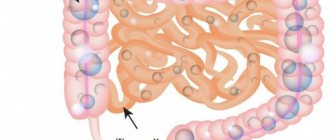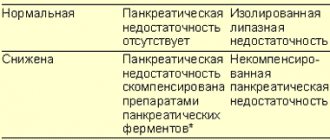Flatulence is a state of increased gas formation in the intestines. In infants, it is due to the beginning of the formation of gastrointestinal microflora and general adaptation to new conditions of life and development outside the womb.
An inevitable and conditionally normal phenomenon. However, it can also be a sign of a serious disorder - dysbiosis or lack of enzyme for digesting lactose, infection.
It is important to know: physiological flatulence is not accompanied by vomiting, frequent and loose stools, or fever. To exclude a serious gastrointestinal disease, you need to consult a pediatrician and not self-medicate.
Types of flatulence
Psychogenic flatulence appears against the background of stress.
Digestive flatulence. Caused by the presence of undigested food particles in the intestines, their processing by microflora with subsequent gas formation.
Dynamic flatulence occurs against the background of impaired motor function of the gastrointestinal tract (or abnormal position and structure of the colon).
Dysbiotic flatulence. Caused by the presence of pathological bacteria in the intestines in predominant quantities compared to beneficial ones.
Alimentary (food) flatulence is associated with the consumption of foods, the digestion of which leads to the formation of gases. Psychogenic flatulence. It is a consequence of stress, hysteria and other mental disorders.
Signs of colic
A baby's tummy can hurt for various reasons. Colic is not always to blame for this. To say with confidence that your baby has colic, you need to make sure that there are several signs:
- the baby’s age is more than 2-4 weeks and less than 5 months;
- regular bouts of prolonged crying for no apparent reason, which begin and end suddenly;
- attacks occur in the late afternoon;
- the child draws his legs in, twists them, his face turns red, his stomach is tense, and after the gas passes, relief comes for a short time.
Attention, there is no such thing as colic:
- Fever;
- Vomiting;
- Blood in the stool;
- Constipation, diarrhea;
- Delay in physical development, lack of weight gain.
Any of these signs, individually or in combination, require consultation with a doctor!
Causes of flatulence in infants
The main reason for gas formation is a lack of enzyme for processing lactose.
The causes of increased gas formation can be both the anatomical characteristics of the child and external factors:
- Underdevelopment of the internal secretion organs responsible for the production of enzymes;
- Imperfect motility of the stomach walls;
- Unformed intestinal microflora (dysbiosis);
- Lack of enzyme for processing lactose;
- Improper organization of children's nutrition: without taking into account age characteristics, overfeeding, lack of a balanced diet (monotonic diet in favor of either fats, proteins, or carbohydrates), consumption of milk (with lactase deficiency);
- Swallowing air while breastfeeding or bottle feeding;
- Feeding with unsuitable formulas: intolerance to their components;
- Violation of the diet of a nursing mother: consumption of gas-forming products;
Specific causes of increased tone and the occurrence of spasms of the stomach walls include: stress, nervous disorders and other mental disorders.
Colic in a newborn - what is it?
Infant colic is a sudden attack of causeless restlessness in newborns. This is a functional disorder of the child's digestion. Simply put, they are not associated with illness or abnormal structure of organs, but are caused by age-related characteristics of the baby’s gastrointestinal tract.
It is important!
Infant colic is not a disease.
They occur in completely healthy newborns. Intestinal colic occurs in every fifth newborn. Why they happen to some babies and bypass others is not entirely clear. But there are reasons that can worsen the baby’s condition. Colic can occur if a nursing mother eats a lot of flour, sweets, raw vegetables and fruits, and dairy products. The latter can also provoke colic if the newborn is allergic to cow's milk protein. In bottle-fed babies, colic can be caused by the wrong formula. Babies who have experienced difficult childbirth or caesarean section are also at risk.
Prevention and treatment of flatulence in infants
Acidolac treats food allergies.
Treatment of flatulence in infants is aimed at eliminating the causes of its occurrence.
One of them is indigestion of lactose (lactase deficiency). Milk is the main food product for infants.
It is beneficial due to the milk sugar present in its composition - lactose. Under the influence of the enzyme lactase, it is broken down into glucose and galactose and absorbed by the intestines.
Colic and other “tummy problems” in babies
Izyakov Dmitry Nikolaevich
Pediatrician
April 25, 2021
Colic
This term hides two problems associated with pain and discomfort in the abdomen in children. There are two concepts in domestic and Western medicine, and two names: intestinal and infant colic.
Domestic medicine understands intestinal colic episodes of abdominal pain associated with:
- with spasm of the intestinal muscles
- and/or with gas overflow (flatulence)
- and/or difficulty promoting content.
Western medicine understands infant colic episodes of crying.
- starting at 3 weeks of age
- occurring at least 3 times a week
- lasting at least 3 hours a day (rule of three triples)
- arising for no apparent reason
- usually at the same hours
- ending just as spontaneously with a sharp return of the child to his usual mood.
The cause of infant colic has not yet been reliably established, but there is increasing evidence that this is a variant of migraine, only it is not the head that hurts, but the nerve plexuses in the abdominal cavity. Hence, there are two fundamentally different approaches to treatment.
The first is the impact on the child . The second is the impact on the child’s mother .
During the first approach, the doctor may recommend and/or prescribe:
For prevention:
- a nursing mother's diet
- replacing formula for a formula-fed baby
- correction of frequency and volume of food
- individual prescription of complementary foods
- additional water addition
- additional placement on the stomach
- belly massage
- gymnastics for abdominal muscles
- medications to prevent spasms, flatulence and difficulty moving contents
To treat seizures:
- to relieve spasms: heat on the stomach, abdominal massage, a short period of hunger when the child is given only water, on the contrary - frequent breastfeeding, medicine (antispasmodic)
- to eliminate flatulence: gas tube, medicine (carminative or defoamer)
- to speed up the passage of contents: pressing the legs to the stomach, enema, medicine (laxative or prokinetic)
During the second trip, the doctor may recommend and/or prescribe:
- alternate presence of different family members with a crying child
- change of environment during an attack
- more frequent feeding
- simple psychotherapy methods for mom
- medications for mom: anxiolytics or sedatives
- pain reliever for a child based on paracetamol (up to 3 months) or ibuprofen (from 3 months).
I would especially like to emphasize that we are talking about abdominal pain that is not dangerous to the life and health of the child. Any attack of abdominal pain, the cause of which the parent does not understand, requires seeing a doctor! If an attack of abdominal pain is accompanied by one or more of the following symptoms:
- complete abstinence from food and drink
- vomiting
- temperature rise above 37.5°C
- any skin rash
- loss of consciousness
- increasing lethargy
- then an emergency call must be made immediately!
Intestinal dysbiosis
This term exists only in domestic medicine, and it refers to a quantitative and qualitative change in the composition of the intestinal microflora, detected by stool culture. This is NOT a disease, since it does not have any significant symptoms, except for harmless and medically insignificant changes in the color, consistency, and smell of stool. And therefore does not require treatment with drugs.
For correction, numerous dietary supplements are used, which should be discussed with your doctor. Dysbacteriosis is a consequence of any disease, so efforts to eliminate it should not replace the search for and treatment of the primary disease. In a doctor’s diagnosis, this term cannot be used independently, but only as a consequence or complication of the underlying disease.
Changes in baby's stool
Color. For a doctor, only three options are significant:
- colorless (i.e. white) – a sign of liver and/or biliary tract disease
- black – a sign of bleeding above or at the level of the stomach
- red (namely scarlet or crimson) is a sign of bleeding from the intestines or obstruction.
No other colors are medically important. But, as practice shows, color is very important to many parents, which is a reason for unreasonable visits to the doctor.
Smell. The putrid smell has a certain significance. All the rest - nothing, but again they can bother parents, and they can bother doctors.
Consistency. Hard and dense, making it difficult to empty – a sign of constipation. Watery and very runny is a sign of diarrhea. All other options should not be a reason to seek medical help.
Frequency. What matters is only an increase in frequency relative to normal with a simultaneous increase in the amount of feces per day = diarrhea. When breastfeeding, stool retention of any duration without difficulty defecating is not constipation. A baby who is exclusively breastfed can have bowel movements no more often, but sometimes the same as the frequency of feedings, as well as empty his bowels WITHOUT difficulty once every 7-10 days.
Impurities. The following impurities in stool are important: streaks of blood, drops of scarlet blood, mucus. All other impurities have no medical significance.
Constipation
This term refers to the difficulty of bowel movements, both with and without a change in stool frequency. The causes of constipation are varied and identifying them is the task of the doctor. To help the doctor find out the reasons, parents should know: what stool looks like after a bowel movement, it is important whether it is thick, or vice versa, liquid and
when the child begins to urge for the next bowel movement.
To help with constipation, the home medicine cabinet should have: 1) a gas outlet tube with a restrictor 2) glycerin suppositories for children 3) therapeutic microenemas "Microlax" They are used in this sequence when a child has a urge, but there is no bowel movement during the day/night (12 hours).
First, install the tube. If there is no effect after 30 minutes, then light a candle. If there is no effect for 2 hours, then give a microenema. Laxatives for oral administration and enemas should not be used without a doctor's prescription.
Diarrhea (diarrhea)
This term refers to an increase in stool frequency and/or stool volume over a 24-hour period. Absolutely any diarrhea is grounds for consulting a doctor, even if the parent seems to know the cause and has experience in dealing with it. Remember that behind any diarrhea there may be an intestinal infection that is life-threatening for the child!
However, there are two remedies that parents can use for primary care:
- rehydration agent = desoldering by age - “Humana electrolyte 0-12” diluted according to instructions. Give 10-20 ml to each chair for a child up to one year old.
- enterosorbent based on smectite - “Smecta” or “Neosmectin” For every 12 hours of diarrhea, use 1 powder diluted in 50-100 ml of water, which the child should drink between feedings, 10-20 ml per hour.
No other means should be used WITHOUT a doctor’s prescription and tests.








